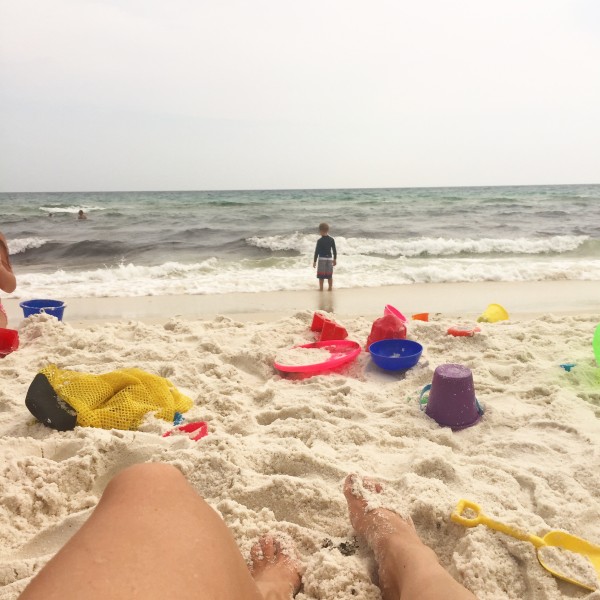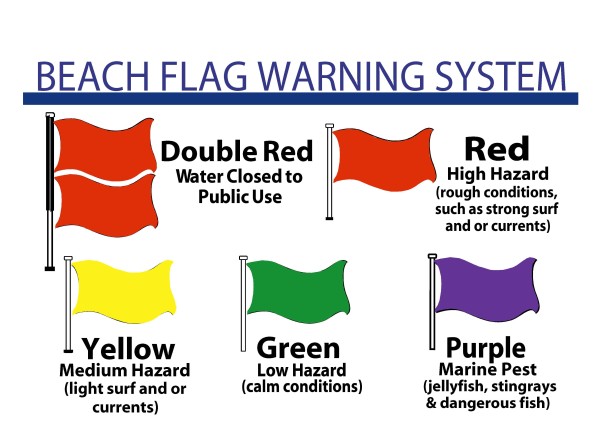Yesterday we took the kids to the beach and the flags were flying at yellow (medium hazzard). The photo below captures just how rough the current was, making me more nervous than usual. As much as I love the beach and creating memories with the girls, it’s not always the most relaxing environment.

Normally I worry about my kid’s safety around swimming pools, however each year during our visit to the Emerald Coast, my concern for beach safety is even higher.
It’s important to take safety precautions around all water environments, especially at the beach due to the large crowds of people and the strength of the ocean. According to the Center for Disease Control, about half of all drowning incidents occur in natural water settings such as lakes, rivers, or oceans. With summer beach season in full swing, there are steps parents can be taking to keep their children safer in and around the ocean.
We’ve teamed up with The United States Swim School Association to share the following guidelines to help keep children as well as adults during a day at the beach. Most of these beach safety tips are common sense but definitely great reminders.
Tips for Beach Safety
Pay attention to the beach flag warnings: Teach your children about the beach flag warning system and what each color represents. They will tell you if the water is dangerous, moderately rough or calm and they will also tell you if there is any aquatic life in the swimming area (jellyfish, sharks, etc.). Before the girls hit the water, I showed them the flag, explained why it was yellow, why the waves were higher than normal AND why it was important they paid attention to the current.

Create a Beach Plan: There are a few entrances to the beach, choose one location to have to meet in case you get separated. If there is a lifeguard on duty where you will be swimming, introduce your child. Make a family rule the kids must check in with you every 30 minutes at least. I also use the rule – if you can’t see me you are too far away.
Pay close attention to your children: This may seem like a no-brainer, however it’s easy to start chatting with friends and look away. Even if there are lifeguards, the ocean is much larger than a pool and the water is much stronger. It only takes seconds for kids to drift away in a strong current. Even at yellow, we had to constantly tell the kids to come back to where we were seated.
Swim in the view of a lifeguard: Teach your children to swim in front of the lifeguard station, most drowning’s occur at an unguarded beach. Also the currents will naturally push you down the shore, have a landmark such as the lifeguard station and return to that spot.
Enter the water feet first: Do not dive into the ocean, test the depth before swimming. Doing this can help prevent serious neck or head injury.
Be aware of rip currents: They are powerful, narrow channels of fast-moving water than can move at speeds of up to eight feet per second. Teach your children about rip currents and how to swim out of them. The best thing to do when caught in a rip current is not to panic, swim parallel to the shoreline until you are out of the current, then swim diagonally back to shore.
Be aware of your surroundings: Teach children the signs of a swimmer who might need help or is having difficulty staying afloat. We used the buddy system. None of the kids were allowed to swim solo, they always had to be with someone at all times while in the water.
Wear a life jacket: the ocean is a strong force and can even be difficult for the best swimmers. As extra safety, wear a life jacket to help stay afloat and above the surface of the ocean. We gave each kid some type of float or boogie board. I like the idea of a life jacket for additional safety.
Pay attention to weather conditions: Never swim when lightning is present. Wait at least 30 minutes after the last thunder boom before heading back out to the sand.
Swimming lessons are a great addition to help keep your child safer while swimming in the ocean. I had the girls take several private lessons before we left for Florida this year. This significantly helped my youngest and gave me a little peace of mind.
To find a USSSA affiliated swim school near you, or for details on becoming a member of the nation’s leading swim school organization visit: www.usswimschools.org.
How are you staying safe at the beach this summer?
About US Swim School Association: US Swim School Association (USSSA) began in 1988 to fill a gap in the swim school industry. USSSA has become the largest and preeminent swim school association in the country with over 400 members providing swim and water safety instruction to over 500,000 students each year. Swim schools receive invaluable benefits as USSSA members, receiving the latest training in water safety, swim instruction methods and tools, invitations to annual conferences, and many other benefits that help establish and build each individual business. USSSA has partnered with Safer 3 Water Safety Foundation for its official water safety program. Through USSSA, parents and students are provided with a reliable and trustworthy resource when searching for a swim school and can rest assured they have chosen a top school when they choose a USSSA affiliated location. For more information, visit www.usswimschools.org.
This is not a sponsored post.
